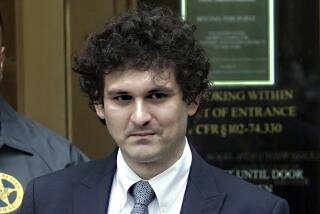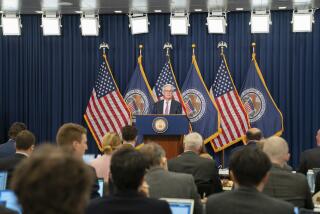Fiscal foolishness
- Share via
The deepening calamity now spreading from financial markets to the broader economy results from the failed fantasy that markets can regulate themselves.
We supposedly learned this lesson once, after the crash of 1929. In the aftermath, we built a dynamic system of managed capitalism so that a financial collapse would never again create a Great Depression.
But beginning in the 1970s, free-market economists and financial elites convinced Congress and presidents of both parties that a deregulated economy would be a more dynamic one; that something new about technology or trade or ideology meant that markets were at last truly self-governing.
New, exotic forms of financial engineering proliferated. These were praised as improving efficiency.
We have just had a full field test of free-market ideology, and once again it failed.
Revisit the financial abuses of the laissez-faire 1920s and you will find different details but the same essentials: deceptive claims about stocks, bonds and balance sheets; conflicts of interest on the part of insiders; excess leverage to finance speculative bets; financial engineering that extracts wealth and does nothing for the real economy. In the ‘20s, National City Bank turned dubious loans into bonds; in this decade, its successor, Citigroup, did the same in the sub-prime mess.
The regulatory system constructed by the New Deal was intended to limit these temptations. Government mandated extensive disclosures and bank supervision, and it prohibited a broad range of conflicts of interest. Commercial banking was separated from the underwriting and sale of securities.
That regulatory system anchored 30 years of broadly distributed prosperity after World War II, an era when the financial economy played its appropriate role as servant rather than master of the real economy.
But as Congress dismantled one regulation after another, the abuses of the ‘20s seeped back into deregulated financial markets, enriching insiders, setting up the broader economy for a crash.
In the sub-prime affair, unregulated mortgage lenders threw away underwriting rules and made teaser loans to people with sketchy credit histories. In more than half the cases, they didn’t even ask for the borrower’s income.
But in the Alice-in-Wonderland world of financial deregulation, a Wall Street bank could turn the loan into a bond; a credit rating agency using obscure alchemy could bless the bond with a triple-A rating, and some consenting adult could be found to buy it. At each step, bankers, brokers and bond-raters could conveniently extract fees.
The whole daisy chain was unregulated and opaque -- to investors, to regulators, even to the investment bankers who orchestrated it. Nobody really knew what these bonds were worth if they ever had to be sold. Now we are finding out.
Had regulators simply required all mortgage lenders to use prudent underwriting standards, the sub-prime crisis never would have happened. This is not Monday-morning quarterbacking. Congress, in a rare bout of pro-consumer regulation, passed a law in 1994 requiring exactly that. But the Federal Reserve, a devout believer in the magic of markets, refused to issue regulations.
Sir John Templeton observed that the four most dangerous words in the English language are “this time it’s different.” Alas, the vulnerabilities and abuses of a speculative, laissez-faire economy are enduring.
Yet there is one key difference between 2007 and 1929. Today’s Federal Reserve is a lot better at bailing out Wall Street’s failed speculative bets. That’s why we’re probably in store “only” for a market tumble and a bad recession, and not another Great Depression.
But the Fed’s rescues are not without cost. By lowering interest rates to a level below what it considers prudent, merely to bail out speculative damage, the Fed courts inflation and increases pressure on the dollar. Cheap money, absent regulation, also invites the next round of speculative excess.
The Fed, of course, is part of the government. The fact that the Fed and the Treasury are scrambling to rescue Wall Street from its own excesses is one more piece of proof that markets don’t regulate themselves.
The very least the Fed and Congress can do is to head off the next wave of abuses now, with tighter regulations.
More to Read
Inside the business of entertainment
The Wide Shot brings you news, analysis and insights on everything from streaming wars to production — and what it all means for the future.
You may occasionally receive promotional content from the Los Angeles Times.










